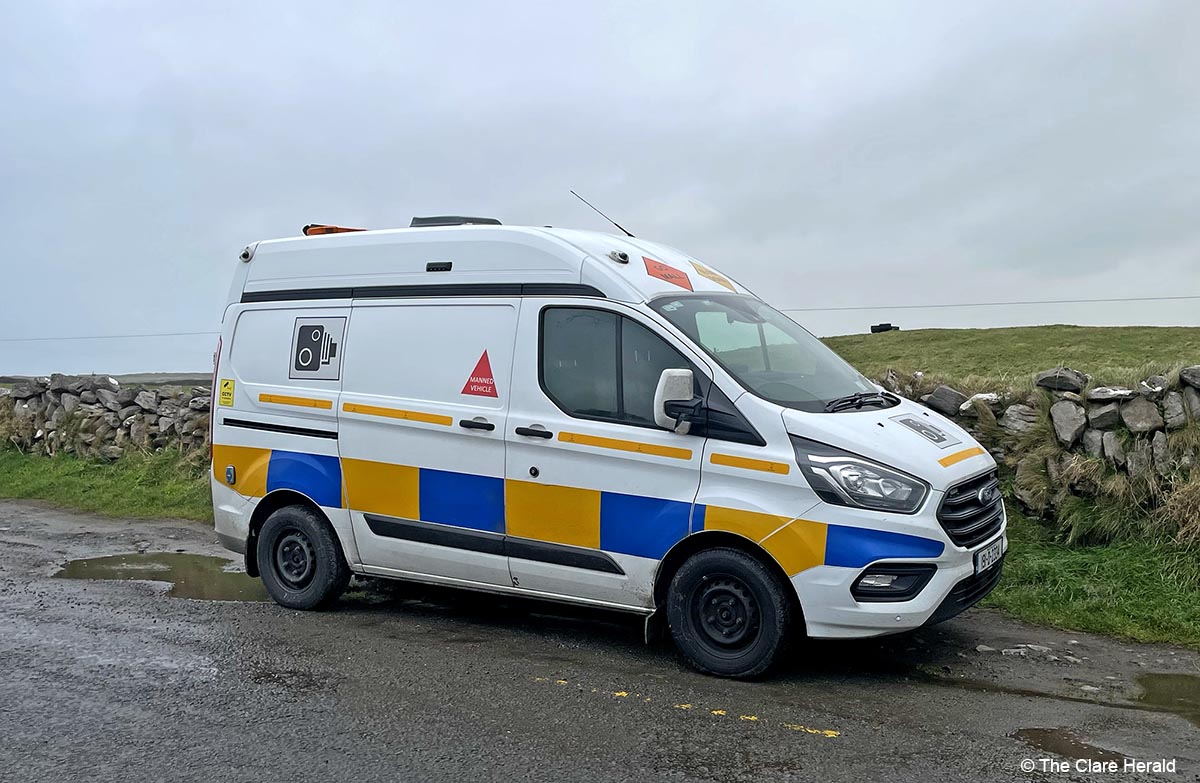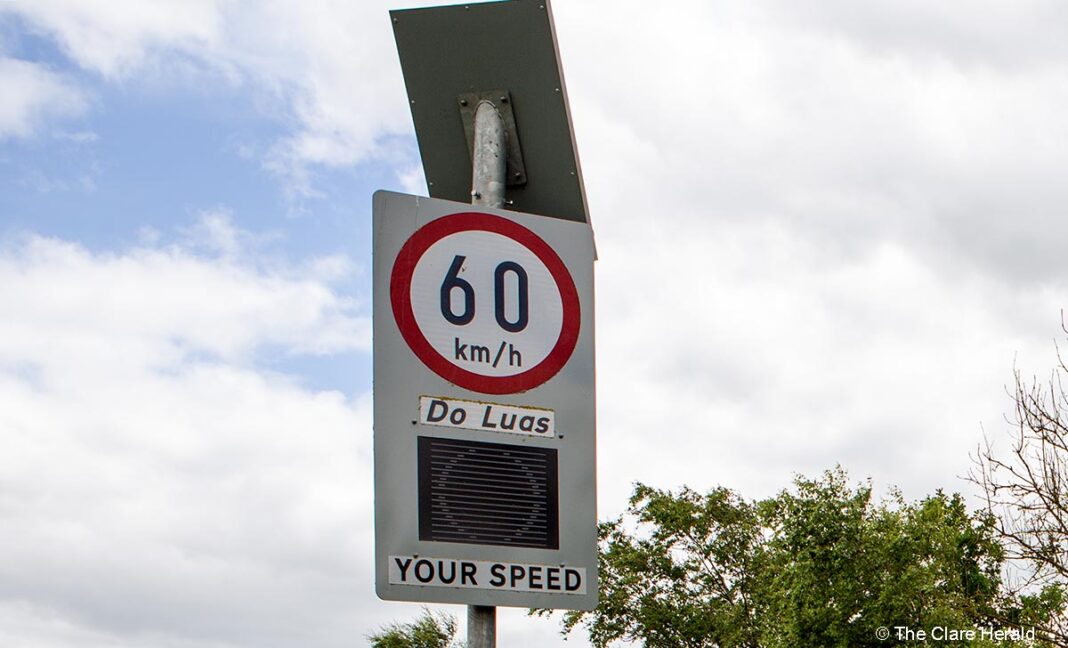Today, (Friday) the speed limit on rural, local roads will change from 80 km/h to 60 km/h.
Rural, local roads primarily serve local traffic and connect our rural communities. These roads are designated with an ‘L’ followed by a number, or do not have a number.
Reducing speed limits is part of the Government’s Road Safety Strategy and is one of a range of measures intended to reduce fatalities and protect all road users.
Local authorities have received grant funding from the Department of Transport to purchase and install poles and signs to display the new speed limit on the relevant roads. The ‘rural speed limit sign’, which is used as an alternative to numeric speed limit signs on specific single lane rural roads, will now mean that a maximum 60km/h limit is in force.
As with all speed limits, it will be an offence to exceed the stated limit. The Department of Transport has been working closely with An Garda Síochána, along with other stakeholders, to ensure that the 60 km/h limit is enforced.
Welcoming the change, Minister for Transport Darragh O’Brien said: “Today’s speed limit reduction will save lives, because driving slower saves lives. Driving at a lower speed means that if you get into a collision, either as a driver or a vulnerable road user, death or serious injury is a significantly less likely outcome. It also means you are less likely to be involved in a collision at all.
“Death and serious injuries on our roads are not inevitable, they are preventable through tangible, sensible measures. This Government is taking action to reduce road fatalities and serious injuries.”
Minister of State at the Department of Transport Seán Canney said: “Today’s speed limit change is an outcome of many years of consultation, deliberation and engagement across the system, most notably from the evidence base of the 2023 Speed Limit Review and close collaboration with local authorities who are implementing this reduction. This welcome change will give us all safer roads.
Systemic changes like today’s speed limit reduction and road safety education – along with enforcement – have helped us significantly bring down road deaths, but in recent years this trend has worryingly reversed. Together we can make our roads safer, by observing the speed limit, driving safely and looking out for one another on rural local roads.”
For more information on speed limits, visit gov.ie/speedlimits
For more information on changes in their local area, people should check with their local authority.

Why are speed limits changing?
Ireland’s Government Road Safety Strategy 2021–2030 has the primary aim of reducing the number of deaths and serious injuries on Irish roads by 50% by 2030, in alignment with targets adopted by Member States across the EU. Internatio-al research indicates that speed is a contributory factor in a third of fatal collisions, and that reducing speed significantly reduces road deaths. The Phase 1 action plan for the Strategy set out the need for a working group of relevant stakeholders to review speed limits, to help set consistent and appropriate speed limits across the road network.
The Speed Limit Review was published in September 2023, and concluded that protecting vulnerable road users must be a key focus when setting speed limits.
Based on modelling and research on international practice, the Review recommended the lowering of default speed limits on urban, local and national secondary roads. This change from 80km to 60km on rural local roads is the first step.
Recommendations from the Review have been incorporated into the Road Traffic Act 2024, which provides the legislative basis for the changes to default speed limits.
For more information on the Speed Limit Review, visit gov.ie – Speed Limit Review
What speed limits are changing today?
The change from 80km/h to 60km/h on rural, local roads is the only change occurring on the road network this Friday. There is no proposal to reduce the default speed limit on ‘Regional Roads’ (roads designated with an R followed by a number), which will remain at 80km/hr.
Future implementation phases will focus on the speed limit in urban cores, which include built-up areas as well as housing estates and town centres, reducing to 30 km/h. The speed limit on national secondary roads is recommended to reduce from 100km/h to 80km/h. Experience from this phase will be used to inform the rollout of subsequent phases on other road categories.
How will the speed limit be enforced?
As with all speed limits, it will be an offence to exceed the stated limit and enforcement will be a matter for An Garda Síochána.
There will be continued collaboration between An Garda Síochána and local authorities to ensure that changes are enforced.
There are a range of measures that are taken to enforce speed limits across Ireland’s road network, including vehicle-mounted and handheld speed-detection equipment, as well as safety-camera vans. The use of speed-detection equipment is necessary to achieve compliance amongst road users. This is particularly important for at-risk locations such as schools, roadworks, and areas used by cyclists and pedestrians. Speed-detection cameras can be deployed through spot checks, mobile vans (currently GoSafe vans) and more recently, average speed and static cameras.
An Garda Síochána have noted that “There can be no transitionary period. From Friday 7 February, those travelling faster than the new legal speed limit on rural roads will be liable for prosecution.”
For more information from An Garda Síochána, visit – Safety Cameras Save Lives – Garda.
Was there a public awareness campaign about this?
The Department of Transport launched the Slower Speeds, Safer Roads Campaign in January. This is an integrated advertising campaign incorporating local and national radio, local and national print advertisements, social media advertising, digital display and Out of Home advertising.
The Road Safety Authority (RSA) will launch a public awareness campaign on February 7th to highlight the updated meaning of the ‘Rural Speed Sign.’ This campaign will encompass audio and visual ads across video-on-demand, radio, and social media until the end of the month. The campaign http://rsa.ie/road-safety/campaigns/rural-speed-limit will educate road users on what the sign now means in the context of the change to speed limits for rural local roads. Key stakeholders, including the Department of Transport, Local Authorities and An Garda Síochána, will further amplify the message through their own social media channels.
To further support the ‘Slower Speeds, Safer Roads’ initiative and the reduction of speed limits on rural local roads, the RSA will launch a new TV-led speeding campaign on March 1st. Running for a full month across television, video-on-demand, radio, digital audio, social media, and out of home platforms, the campaign will underscore the dangers of casual increases in speed—particularly on rural roads.
How is the change in road signs being funded?
The Department of Transport is funding procurement of the new poles and signage required for the implementation of the 60km/hour default speed limit on rural local roads, through grant assistance to local authorities. This covers costs associated with the installation of new poles, signage, and related overheads.
This ‘Speed Limit Sign Implementation Project’ funding is one of a range of grant allocations for local authorities for the maintenance and improvement of regional and local roads. In 2025 these will include ‘Restoration Improvement’ and ‘Restoration Maintenance’ programmes, aimed at protecting roads and road surfaces, the ‘Bridge Rehabilitation Programme’, ‘Road Drainage Schemes’, ‘Road Safety Schemes’, and ‘Climate Change Adaptation & Resilience Projects’.
An important element of this funding is targeting significant investment on improving road safety for all road users, including pedestrians and cyclists. It’s important to note that funding one aspect of road safety does not mean others aspects are ignored.
